MCAT p/s 5 - Individuals and Society, Perception, Prejudice, and Bias, Social Behaviour, Social Interactions, Culture, Social Inequality
1/189
There's no tags or description
Looks like no tags are added yet.
Name | Mastery | Learn | Test | Matching | Spaced |
|---|
No study sessions yet.
190 Terms
Self-concept
how someone thinks about/perceives/evaluates themselves
“Self-identity/awareness”
Based on self-esteem and self-efficacy
2 parts:
Existential self
Categorical self
Carl Rogers - 3 components:
Self-image
Self-esteem/worth
Ideal-self
Self-image, self-esteem/worth, ideal-self
3 components of self-concept according to Carl Rogers (Humanistic Theory)
What we believe we are, how much value we place on ourselves, what we aspire to be
Existential Self
Part of Self-Concept
Most basic part
Sense of being separate and distinct from others
Awareness that self is constant/consistent throughout life
Categorical self
Part of Self-Concept
Comes after existential self (realize they’re separate)
Awareness that even though we are separate, we exist in a world with others and everything has properties
Age, gender, skills, size, traits, comparisons, careers
Social Identity Theory
Theory that develops self-concept further
2 parts:
Personal identity
Social identity
How we categorize ourselves and others:
All humans categorize ourselves and others to understand objects and identify them
Identification - adopt identity/role, emotional significance, sense of belonging
Social Comparison - to maintain self-esteem
Self-efficacy
Belief in one’s abilities to succeed in a situation
Developed by Bandora (dissatisfied with idea of self-esteem)
2 types:
Strong - recover quickly from setbacks, strong sense of commitment, enjoy challenges
Weak - focus on failures, avoid challenging tasks, lose confidence easily
Determined via 4 sources:
Mastery of experience
Social modelling
Social persuasion
Psychological responses
Can have low-self esteem, but high _______, vv
Psychosexual Theory
Theory of Development (personality)
Freud
Childhood = most important stage for personality development
Most personality develops by age 5
Influences later behaviour in life
5 stages
If issues - fixation
Oral
Anal
Phallic
Latent
Genital

Oral, anal, phallic, latent, genital
Stages of Freud’s Psychosexual Theory
Oral stage
Stage 1 of Freud’s Psychosexual Theory
0-1 y/o
Libido centered around mouth
Sucking, eating, tasting
Derives pleasure via oral stimulation
Infant dependent on caregivers, develop sense of trust
If fixation: issues with dependency, aggression, smoking, biting fingernails, thumb sucking, overeating
Anal stage
Stage 2 of Freud’s Psychosexual Theory
1-3 y/o
Centered around ____
Toilet training, development of control/independence, feel capable and productive
If fixation: problems with orderliness/messiness
Phallic stage
Stage 3 of Freud’s Psychosexual Theory
3-6 y/o
Discover difference btw males and females
Oedipus/Electra’s complex
Develop similar characteristics as same sex-parent
If fixation: homosexuality, exhibitionism
Latent period
Stage 4 of Freud’s Psychosexual Theory
6-12 y/o
No focus on libido
Period of exploration, intellectual pursuits, social interactions
Important in development of social/communication skills
Concerned with peer relationships, hobbies, play w/ same gender children
Fixation doesn’t lead to adult fixation
Genital stage
Stage 5 of Freud’s Psychosexual Theory
12+ y/o
Develop sexual interests
Before, focus on individual needs, now focus on needs of others
No adult fixation - Mentally healthy
Establish balance between various life areas
Psychosocial Development Theory
Theory of Development (personality)
Erikson
Personality/identity develops through whole lifespan
Each stage depends on overcoming a conflict/crisis
8 stages
0-1 y/o
Crisis: trust vs mistrust
Virtue: hope
1-3 y/o
Crisis: autonomy vs shame/doubt
Virtue: will/independence
3-6 y/o
Crisis: initiative vs guilt
Virtue: purpose
6-12 y/o
Crisis: industry vs inferiority
Virtue: self-esteem/competence
12-20 y/o
Crisis: identity vs role confusion
Virtue: fidelity
20-40 y/o
Crisis: intimacy vs isolation
Virtue: relationships/love
40-65 y/o
Crisis: generativity vs stagnation
Virtue: sense of care for others
65+ y/o
Crisis: integrity vs dispair
Virtue: wisdom, closure
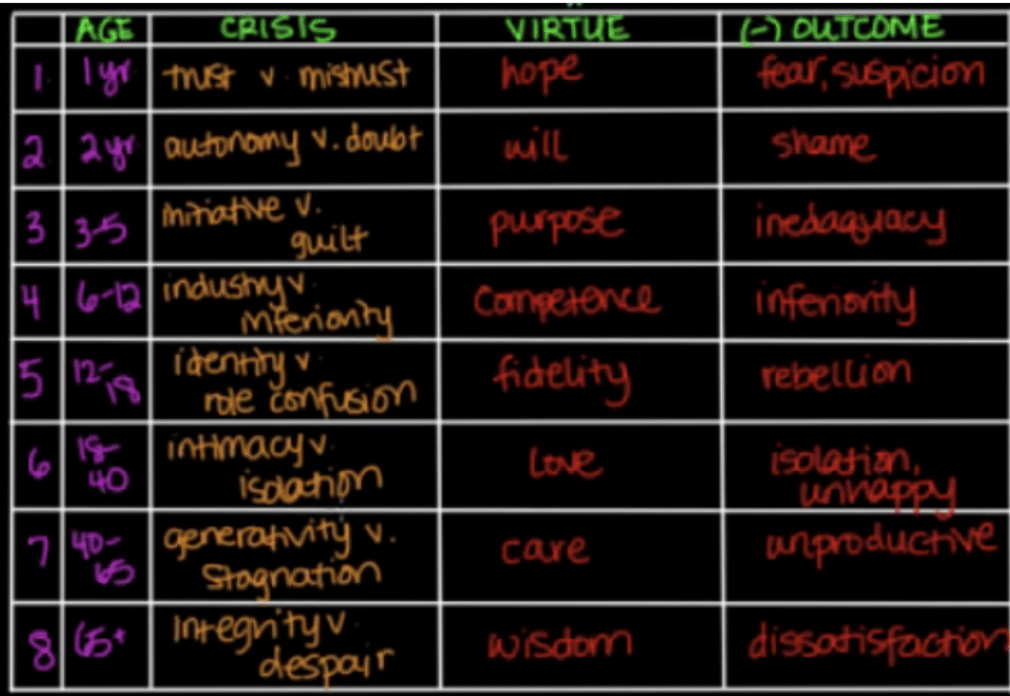
Sociocultural Cognitive Development Theory
Theory of Development (cognition)
Vygotsky
Children learn through active, hands-on processes
4 elementary mental functions: attention, sensation, perception, memory
Develop into higher mental functions - independent learning and thinking
Parents/caregivers/cultural beliefs/language/attitudes responsible for development of higher function of learning
Requires:
Cooperative collaboration with MKO (more knowledgable other)
Zone of proximal development
Language
Social interaction important for cognition

Moral Development Theory
Theory of Development (cognition)
Kohlberg
Right vs wrong
Moral reasoning develops with cognition
Heinz dilemma
3 stages of moral reasoning each with 2 levels - 6 levels total
Pre-conventional
Obedience vs punishment
Individualism and exchange or Self-interest
Conventional
Societal norms
Law and Order
Post-conventional
Social contract
Universal ethical principle
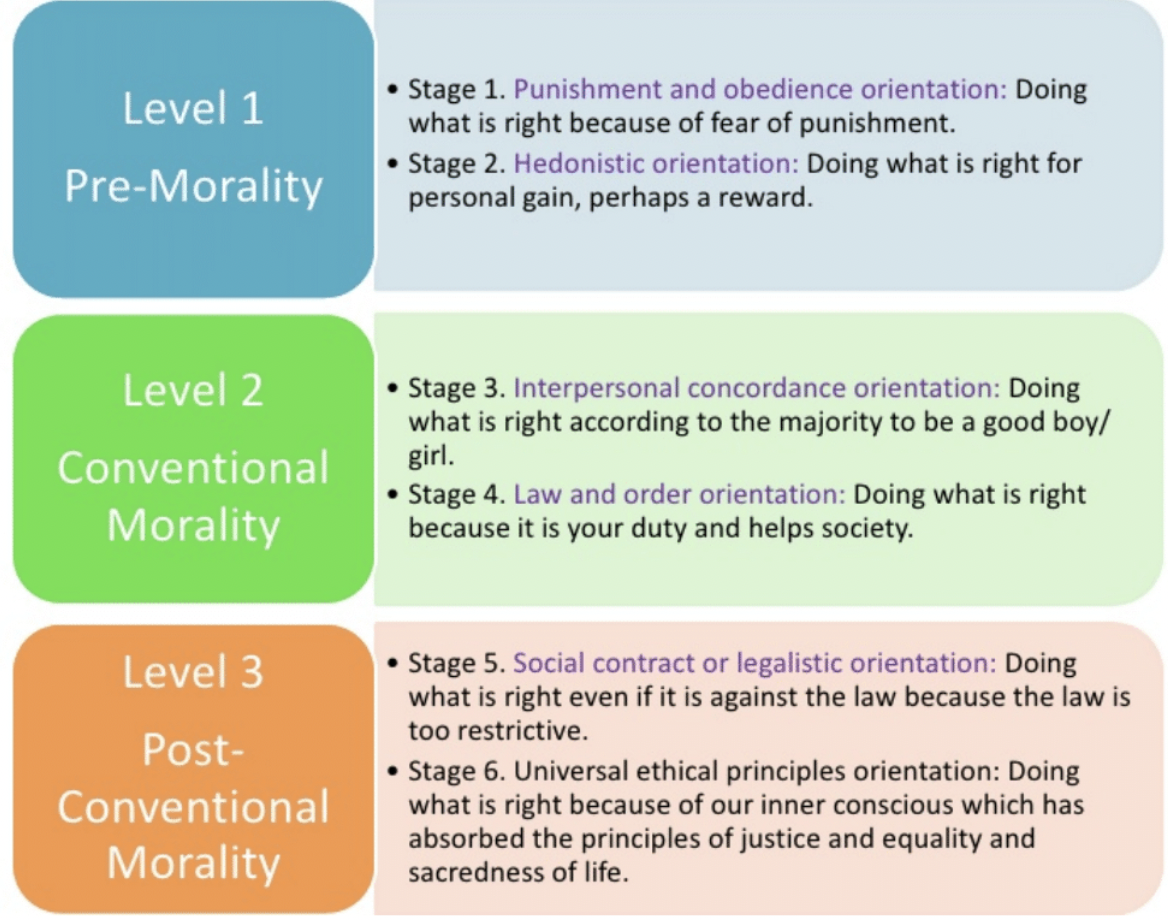
Social Behaviourism
Developed by George Herbert Mead
The mind and self-emerge through the process of communicating with others
Occurs through 3 stages:
Preparatory stage
Interaction through imitation
Begin to communicate with others and use symbols
Play stage
More aware of social interactions
Pretend play
Role-taking
Consider attitudes, beliefs, behaviours of those close to them
Game stage
Start to understand attitudes, beliefs, behaviours of “generalized other”
Others have multiple roles, opinions
Only concerned with reactions of significant others
Development of I and Me
Me = Socialized and conforming aspect of self
I = spontaneous, less socialized component of the self
Actual self = balance of I and me

Looking glass self
Term developed by Charles Cooley
Describes process by which socialization shapes our self-image and self-concept
Idea that a person’s sense of self develops from interpersonal interactions with others
3 steps:
How do I appear to others?
What must others think of me?
Revise how we think about ourselves
Not actually being influenced by opinions of others, but what we imagine the opinions of other people to be
Attribution theory
How we explain behaviours of others around us by breaking down our understanding/explanation of their behaviours to factors about them, and factors related to their environment/surroundings
Internal (dispositional attribution) - about them
External (situational attribution) - environment
Error = assigns too much weight to internal vs external factors as cause of behaviour
Co-variation model
Model related to Attribution Theory
3 cues:
Consistency (time)
Consistency is high = attribution to internal factors
Distinctiveness (situation)
Distinctiveness of a situation = attribution to external factors
Consensus (people)
Consensus of people = attribution of external factors
Fundamental attribution error
Over attribution of others behavior to internal causes
Occurs when a person assigns too much weight to internal causes rather than external factors when looking for causes of another person’s behavior
Stereotype threat
Exposure to a negative stereotype surrounding a task can actually cause decrease in the performance of an individual performing task
Stereotype, prejudice, discrimination
Prejudice is made up of 3 components
Cognition ( ____ ) - fundamental underlying thought, overgeneralized belief
Affect ( ____ ) - emotional component
_______ - capacity to carry out a behavior and act on prejudice
Social stigma
Stigma fuelled or associated with stereotypes, prejudices, discrimination
Associated with a behavior, identity, or other attribute that is considered deviant by others
Self stigma
Type of stigma where an individual can internalize all the negative stereotypes, prejudices, and discriminatory experiences they’ve had, and may begin to feel rejected by society, avoid interacting with society
Halo effect
Tendency people have inherently good/bad natures, rather than looking at individual characteristics
Ex. If we have an overall positive first impression, we start to analyze all their skills based on our overall first impression rather than just skills. They get an overall boost in each of their skills because of our impression
Often happens with celebrities and attractive people
Ethnocentrism
judging someone else’s culture from the position of your own culture
Viewing our own culture to be superior to that of others
Can lead to cultural bias and prejudice
Using one’s own cultural standards, such as norms and values, to make judgements about another culture
Cultural relativism
Practice of assessing a culture by its own standards rather than viewing it through the lens of one’s own culture
Opposite of ethnocentrism
No absolute right or wrong, but we have different cultures which are themselves valid
Xenocentrism
Judging another culture as superior to one’s own culture
Cultural imperialism
The deliberate imposition of one’s own cultural values on another culture.
Development of “in” and “out” groups
In-group favouritism
We favour/friendly to people in our own group
But, to out-group, neutral–we don’t give them favours we do to our in-group
Out-group derogation
We are super friendly to our in group, but not friendly to out group–we discriminate
Happens if we feel that the out group is threatening to undermine in group’s success
Kin selection
People act more altruistically towards those more closely related to them
Gives evolutionary advantage, passing on genes
Reciprocal altruism
People more likely to act altruistically with the expectation that they will receive some benefit in return in the future
We feel more obliged to help someone else if they have helped us
Cost signalling
Altruism, although costly, benefits the altruist by allowing them to establish a “reputation”; one that allows him her or her to say, “look how great I am. I’ve contributed to people who are less fortunate!
Role strain
When you can’t carry out all obligations of a status
Causes individual to be pulled many directions by one status
Ex. a student has to write two papers, five reading assignments, give a speech, two lab reports in one week
Role conflict
Conflict/tension between two or more different statuses
Statuses compete for one’s time
Ex. someone who’s is a parent, friend, husband, and worker
Defined as the stress that people feel when they are confronted within compatible role expectations across different social statuses they occupy
Role exit
When an individual stops engaging in a role previously central to their identity and the process of establishing a new identity
Primary groups
Closest members of the group to you
Close intimate long-term relationships
Give a sense of belonging and loyalty and shared identity
Not in it for some sort of goal
Secondary groups
Formal, impersonal, temporary, and business-like relationships, based on a limited purpose/goal
Usually short-term and see infrequently
Dramaturgical approach
Sociological perspective developed by Erving Goffman
Views social interactions as performances, like a theatrical play, where individuals act out roles and manage impressions for an audience
2 parts:
Front stage - when in a social setting
Back stage - more private areas of life, when act is over, can be yourself and do what makes you feel comfortable
Impression management = attempt to control how others see us on the front stage
Work on it on the backstage
Utilitarian organization
Type of Organization
Members are paid/rewarded for their efforts
Ex .Businesses and government jobs, and universities(receive diploma in exchange for your time)
Normative organization
Type of Organization
Members come together through shared goals
Ex. religious groups or MADD
Positive sense of unity and purpose
Coercive organization
Type of Organization
Members don’t have choice about membership
Ex.people in a prison, or the military
Usually highly structured and have very strict rules
Foraging
The search for food in animal’s environment
Can’t survive or reproduce without it
Takes lots of time and E to find food
Goal is to get highest energy yield while expending least amount of energy
Can be solitary or in a group
Random Mating
All individuals within a species are equally likely to mate with each other
Mating not influenced by environment/heredity or any behavioral/social limitation. Ensures a large amount of genetic diversity
Assortative Mating
Non-random mating where individuals with certain phenotypes/genotypes/similarities/genes/physical appearance tend to mate with each other at a higher frequency
Can lead to inbreeding and the passing on of harmful recessive traits
Non-Assortative Mating
Situation where individuals with different or diverse traits mate with higher frequency than with random mating
Inclusive fitness
Concerns the # of offspring an animal has, how they support them, and how offspring support each other
Thinking about fitness on a larger scale–evolutionary advantageous for animals to propagate/survival of closely related individuals and genes in addition to themselves
Macrosociology
Large scale perspective, looking at big phenomena that affect big portion of population
Social structures and institutions, whole civilizations/populations
Looking for patterns and effects the big picture has on lives on small groups
Broad social trends in cities, and statistical data
Poverty, war, health care, world economy
Functionalism
Comes from macrosociology
Looks at society as a whole and how institutions that make up the society adapt to keep society stable and functioning
Conflict theory
Comes from macrosociology
The idea society is made of institutions that benefit powerful and create inequalities
Large groups are at odds until conflict is resolved.
Microsociology
Face to face interactions, families, schools, other social interactions
Interpretive analysis of the society, look at sample of society and how individual interactions would affect larger groups in society
Symbolic interactions
Comes from microsociology
Social theory that focuses on the individual and significance they give to objects, events, symbols, etc. in their lives
Social epidemiology
The contribution of social and cultural factors to disease patterns in populations (the social determinants of a disease)
Emphasized how social factors, such as class or race/ethnicity, affect the distribution of disease and health
Functionalism
A system of thinking based on ideas of Emile Durkheim that look at society from large-scale perspective, and how each part helps keep society stable
Society is heading towards equilibrium
Macro-sociological analysis, with a broad focus on social structures that shapes society as a whole
Balance between institutions and social facts (ways of thinking and acting formed by society that existed before any one individual and will still exist after any individual is dead)
a change to production/distribution/coordination will force others to adapt to maintain stable state society
Problem: focuses entirely on institutions without regard for individual
Social Constructionism
Argues that people actively shape their reality through social interactions/agreement–it’s something constructed, not inherent
Things are social products made of the values of the society that created it
Theory that knowledge is not real, and only exists because we give them reality through social agreement–nations, books, etc. don’t exist in absence of human society
Can be:
Weak
Social constructs dependent on brute facts and institutional facts
Strong
Dependent on language and social habits
all knowledge is social construct and there are no brute fact hat just exist
Difficulty explain natural phenomena that don’t depend on human action
Berger and Luckman
Symbolic Interactionism
Examines small scale social interactions, focusing attention on how shared meaning is established among individuals or small groups
Explains social phenomena in terms of the meanings that they hold when people interact with one another
Developed by George Herbert Mead
Continued by Herbert Blumer - 3 tenants:
We act based on meaning we have given something
Different people assign different meanings to things. We give meaning to things based on social interactions
The meaning we give something isn’t permanent
Problem: restricted to small interactions, doesn’t ask same questions that large-scale sociologists do
Feminist Theory
Look at world from macro-perspective, originated from conflict theory by looking at inequalities in society
Examines women’s social roles/experience in education, family, and workforce
Women face discrimination, objectification, oppression, stereotyping
Different types:
Gender differences
Gender inequality
Gender oppression
Structural oppression
Not an attempt to replace men–different perspective on society to point out inequalities that exist between men and women due to institutions of society
Rational Choice Theory
People not only motivated by money, but do what’s best to get better
Main assumption is the idea that everything people do is fundamentally rational to maximize personal gain
People act in self-interest, driven by personal desires and motivated by goals
People calculate the cost and benefits of each action and choose the one with the best outcome for themselves
3 main assumptions:
Completeness (every action can be ranked)
Transivity
Independence of irrelevant alternatives
Exchange Theory (Exchange-Rational Choice Theory)
Application of rational choice theory to social interactions
Used to study family relationships, work relationships, partner selection, parenting, etc.
Behavior of individual in interaction can be figured out by comparing rewards and punishments
Assumptions:
People seek to rationally maximize their profits, behavior resulting in a reward is likely to be repeated
Conflict Theory
How societies change and adapt over time through conflict
Two opposing positions would merge to create a new society where both are content.
Ex.Class struggle of 19th century Europe
Life Course Theory
Aging is a social, psychological, and biological process that begins from time you born till time you die
A holistic perspective that calls attention to developmental processes and other experiences across a person’s life
Age stratification theory
suggests age is a way of regulating behavior of a generation
Activity Theory
Looks at how older generation looks at themselves
Certain activities or jobs lost, those social interactions need to be replaced so elderly can be engaged and maintain moral/well-being
Disengagement Theory
Older adults and society separate, assumes they become more self-absorbed as they age
Separation allows for self-reflection
But considers elderly people still involved in society as not adjusting well, which is debatable
Continuity Theory
People try to maintain same basic structure throughout their lives overtime.
As they age people make decisions that preserve that structure and use it to adapt to external changes and internal changes of aging
Gender schema
Theory that explains how individuals should be gendered in society
How sex-linked characteristics are maintained and transmitted to other members of a culture
What constitutes male/female characteristics and how stereotypes become ingrained in the society
Cognitions regarding what constitutes sex identity is a ____ ______
Gender script
What we expect males and females to do
Organized information regarding the order of actions that are approximate to a familiar situation
Suburbanization
Movement away from cities to get a larger home (American dream), but commute for work can be long and harder to get quick medical help
However, suburbs form their own economic centres and become independent to cities they border
Fertility
Factor of Population Growth Rate
Natural ability of human beings to have babies, which add to the population
Measure birth rate by # of births/1000 people per yr
or _____ rate # number of births a woman is expected to give birth to in her child bearing years
Average = 2.1
(#births + #immigration) / 1000
Total population increase rate
Fecundity
the potential reproductive capacity of a female
Affects population growth rate
Migration
Factor of Population Growth Rate
Number of people moving permanently (to live, work, and eventually die) into/out of countries
Doesn’t change total people on planet but does change # of people living in a region/country
Immigration/Emigration
Net ______ = immigration - emigration
People are moving to industrialized countries for potential for better life. Move for political reasons (become refugees), for jobs, or wanting to live somewhere foreign.
Mortality
Factor of Population Growth Rate
Death, decreases population
Death rate = #deaths / 1000 people
Population pyramid
Graphs the age and sex distribution of a population
Males/Females on x-axis and increasing age on y-axis
Stationary/constrictive = low birth/death rates
Expansive = high birth and death rates

Stationary/constrictive population pyramid
Population pyramid indicating low birth and death rates in population
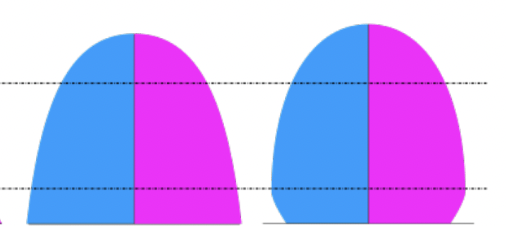
Expansive population pyramid
Population pyramids indicating high birth rate and high death rates
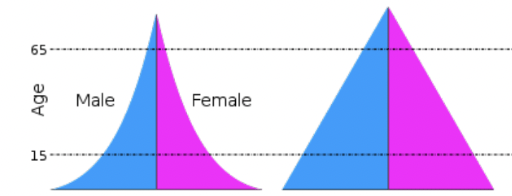
Constrictive period
Fewer young people than old people (in developed countries)
Mortality rate of country with lots of old people does not compare well with a country where people are dying young from disease
(#death + #Emigration)/1000
Total population decrease rate
Life-table/mortality table
When you break mortality rate by age
Tells you probability someone will die given their age which can vary from country to country
Internal migration
Move within same country
Doesn’t change population of a country, but can effect economics/culture of a country
Large factor in urbanization (movement from rural to urban areas)
Growth rate
(Total Population Increase–Total population decrease)/(Initial Population)*100
(Births + Immigration–Deaths–Emigration)/(Initial Population)*100
Can be calculated as Current Population–Initial Population / (Initial) * 100
How much population of a country grows or shrinks over a period of time
Can be negative for some countries, but globally positive
Demographic transition
Theory of economic development and pop change that suggests that economic changes, specifically industrialization affect the relationship between the fertility and mortality rates in a society
Stabilization usually occurs in industrialized/developed countries
Affected by immigration into developed countries
Increases fertility, decreases mortality
Usually healthy people migrating
Population growth occurs rapidly because the mortality rate falls before the fertility rate does. Over time, the fertility rate also falls, thus stabilizing a lower rate of population growth
Shift from high birth and death rate to low death and birth rate as country becomes industrialized
5 stages
High birth and death rates. Stable population.High Stationary Pyramid
High birth rate and declining death rates (better sanitation and foodsupply). Increase in population. Population of older people increases.Early Expanding Pyramid
Lower birth rates (contraceptives, and social values changing) andsometimes continueddecline in death rates. Population stops growing asquickly. Late expansive pyramid
Birth rates and death rates balance. Population stabilizes. Lots ofpeople because of all the growth in 1-3. Low-Stationary Pyramid
Speculative Stage; population could remain stable, increase, ordecrease(decrease=constrictive pyramid). Less births and more deaths
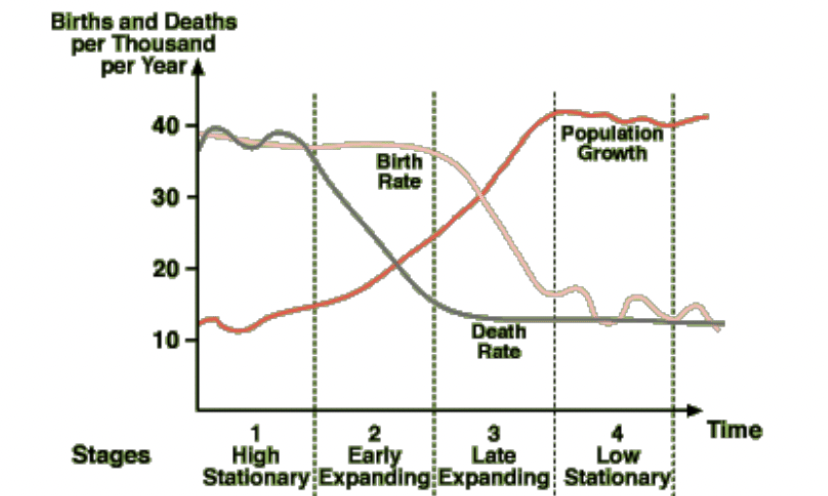
Stage 1
Stage of Demographic Transition Model
High birth rate
Limited birth control
Economic advantage for more workers
High death rate
Disease/poor nutrition
Overall stable pop
Pyramid model = stationary
Lots of young ppl, little old ppl
Ex. most countries prior to 18th century in Western Eu
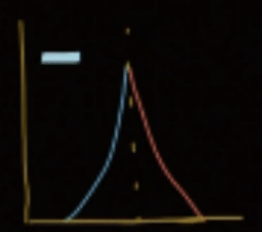
Stage 2
Stage of Demographic Transition Model
Beginnings of developing pop/countries
Still high birth rate
Lower death rate
Availability of food
Health and sanitation
Overall, pop growth
Pyramid model = early expanding
Ex. 19th century Western-Europe after Industrial Revolution
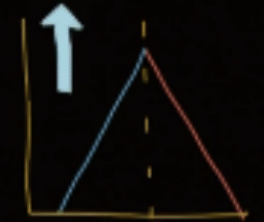
Stage 3
Stage of Demographic Transition Model
Low death rate
Still decreasing
Better health care
Lower birth rate
Begins to decrease
Social trend towards smaller families
In more industrialized countries
Slower population expansion and longer lived elderly
Pyramid model = late expanding
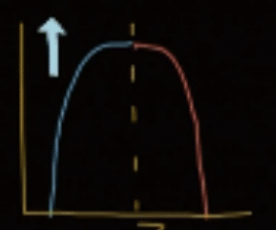
Stage 4
Stage of Demographic Transition Model
Birth and death rates low and balance each other out
Improvement of contraception, women in workforce
Career > kids
Large pop bcs been growing
Pyramid model = low stationary

Stage 5
Stage of Demographic Transition Model
Speculative
World pop forced to stabilize
Malthusian theorem: run out of ressources, global food shortage, can’t maintain natural ressources for everyone on planet - high mortality rate
Lack of resources will lead to public health disaster and force population to stabilize–stabilize and then negative growth rate
Pyramid model = constrictive
Fewer young than old
Some evidence that growth rate could increase - Higher standard of living promote fertility and higher birth rate

Malthusian Theorem
Theory for stage 5 of demographic transition
Run out of resources, global food shortage
We won’t be able to maintain natural resources for everyone on planet → high mortality rate
Anti-Malthusian Theorem
Theory for stage 5 of demographic transition
Couples only want to have one child or have children later in life. (low birth rate)
Better standard of living = smaller families because children are economic burden
Also, industrialized nations have better education/access to healthcare which contribute to reproductive choices
China have government policies to slow population growth to preserve their resources
Globalization
Sharing of culture, money and products between countries due to international trade and advancements in transportation and communication
Contributed to by economic interdependence, tech advancements
Allows for:
International terrorism
Civil unrest
Foreign cultures integrated in each country
World-economy
Core
Division of world according to World-Systems Theory
(importance of world as a unit rather than individual countries)
Western Europe and US
Strong Central Government with enough tax to support it
Economically diversified, industrialized, and independent of outside control
Strong middle and working class
Focus on higher scope production of material goods rather than raw materials
Periphery
Division of world according to World-Systems Theory
(importance of world as a unit rather than individual countries)
Latin America and Africa
Relatively weak government, greatly influenced by and depend on core countries and transnational corporations
Economy focused on narrow economic activity (1 type usually) like extracting raw material
High percentage of poor/uneducated people and strong upperclass that controls most of economy
Huge inequalities
Semi-Periphery
Division of world according to World-Systems Theory
(importance of world as a unit rather than individual countries)
India and Brazil, middle-ground between other 2
Not dominant in international trade but diversified/developed economy
Can come either from periphery countries moving up to core countries or core countries declining towards periphery status.
It is a fluid-model but criticized on being too focussed on core countries and economies and ignoring class struggles and culture of individual countries
Modernization Theory
All countries follow similar path of development from traditional to modern society
With some help traditional countries can develop similarly to how today’s developed countries did
Looks at internal social dynamics as country adapts to new technologies and political and social changes that occurs during adaptation
Dependency Theory
Rxn to modernization theory
Uses idea of Core + Periphery countries to look at inequalities between countries
Periphery countries (3rd world countries) export resources to Core countries (first world)
Not because they are in an earlier stage of development but because they have been integrated into the world economy as an undeveloped countries
Don’t have means to become a developed nation
They will remain poor and dependent on wealthier nations
Hyperglobalist perspective
Sees globalization as a new age in human histor
Countries become interdependent and nation states themselves are less important
Countries become one global society
Theorists don’t agree if this is good or bad
Driven by a legitimate process
Skeptical perspective
Critical of globalization, considers it as being regionalized instead of globalized
Third world countries aren’t being integrated into global economy with same benefits as first world countries
Current economy is not leading towards global capitalism
Transnational corporations still tied to their home countries and national borders remain important
Transformationalist perspective
Doesn’t have specific cause or outcome
Believe national governments are changing, perhaps becoming less important but difficult to explain change so simply
They see the world order is changing
Just a new world order is being developed
Many factors that influence change of world patterns but outcome unknown